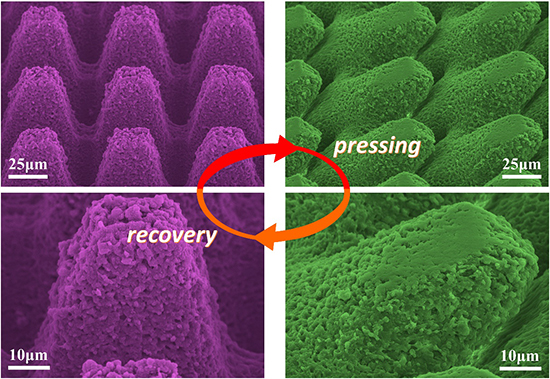Significance
Shape-memory polymers (SMPs) are polymeric smart materials that have the ability to return from a deformed state to their original shape induced by an external stimulus. This unique property results from its characteristic mechanical property that can be dramatically changed near the phase transition temperature. As a result, there has been a surge in interest in these materials credit to their potential application in digital coding, biomedical devices, switchable structured dry adhesives, information carriers, and flexible electronics. Further, due to the excellent shape-memory effect, the SMP surface microstructures can be deformed and recovered, resulting in a reversible transition of superhydrophobicity. Consequently, various researchers have attempted to fabricate superhydrophobic SMP micropillar array through the replica molding method. However, a thorough review of related literature reveals that the approach employed is a multi-step manufacturing process and lacks flexibility. As a special polymer material, not all of the conventional microfabrication methods can build superhydrophobic micro/nanostructures on the SMP surface.
Generally, the development of a simple and effective method to realize switchable superhydrophobicity on the SMP surface still remains a challenge. Recent technological advances have yielded the femtosecond laser. Technically, this laser features ultra-short pulse width and extremely high peak intensity. These properties endow the femtosecond laser with the ability to ablate almost all of the known materials and directly create various micro/nanostructures on the material surfaces through a simple one-step ablation process. Against this backdrop, a recent publication authored by Dr. Xue Bai, Prof. Qing Yang, Dr. Yao Fang, Dr. Jingzhou Zhang, Prof. Jiale Yong, Prof. Xun Hou and Prof. Feng Chen from the School of Electronics & Information Engineering at Xi’an Jiaotong University in China introduced an effective method to prepare superhydrophobicity-memory surfaces on a thermal-responsive SMP by femtosecond laser ablation. Their work is currently published in the research journal, Chemical Engineering Journal.
In their approach, an array of hierarchical micropillars was firstly formed on the SMP surface by femtosecond laser treatment and then was further modified with fluoroalkylsilane. In addition, the stability of the superhydrophobicity of the SMP surface was investigated by sandpaper abrasion, tape peeling test, UV irradiation, and the immersion in different pH solutions.
The authors reported that the obtained SMP surface showed superhydrophobicity and extremely low adhesion to water droplets. In fact, the micropillars on the SMP were observed to lean to one side when the surface was pressed by a force, and they could easily recover to stand state by heating. Additionally, with the reversible switching of the micropillars between original shape and temporary shape, the superhydrophobicity of the resultant surface could be reversibly weakened and re-obtained; thus, showing memory property.
In summary, the study by Xi’an Jiaotong University scientists presented an effective technique for fabricating superhydrophobicity-memory surface that was based on the use of femtosecond laser to treat SMP surface. Results showed that the fabricated superhydrophobic SMP surfaces had excellent resistance to sandpaper abrasion, tape peeling, UV irradiation, and the corrosive solutions with different pH. Further, the superhydrophobicity-memory surface was successfully used as a rewritable platform for directional liquid transportation. In a statement to Advances in Engineering, Professor Jiale Yong highlighted that they anticipated their method of femtosecond laser-induced superhydrophobicity-memory microstructures on the stimuli-responsive materials will have broad applications in switchable wettability, liquid/droplet manipulation, and chemical engineering.

Reference
Xue Bai, Qing Yang, Yao Fang, Jingzhou Zhang, Jiale Yong, Xun Hou, Feng Chen. Superhydrophobicity-memory surfaces prepared by a femtosecond laser. Chemical Engineering Journal, volume 383 (2020) 123143.
Xue Bai, Qing Yang, Jiale Yong, Yongkang Bai, Jiwen Zhang, Xun Hou, Feng Chen. Anisotropic, Adhesion-Switchable, and Thermal-Responsive Superhydrophobicity on the Femtosecond laser-Structured Shape-Memory Polymer for Droplet Manipulation. Chemical Engineering Journal, volume 400 (2020) 125930.

 (创新港)
(创新港)


